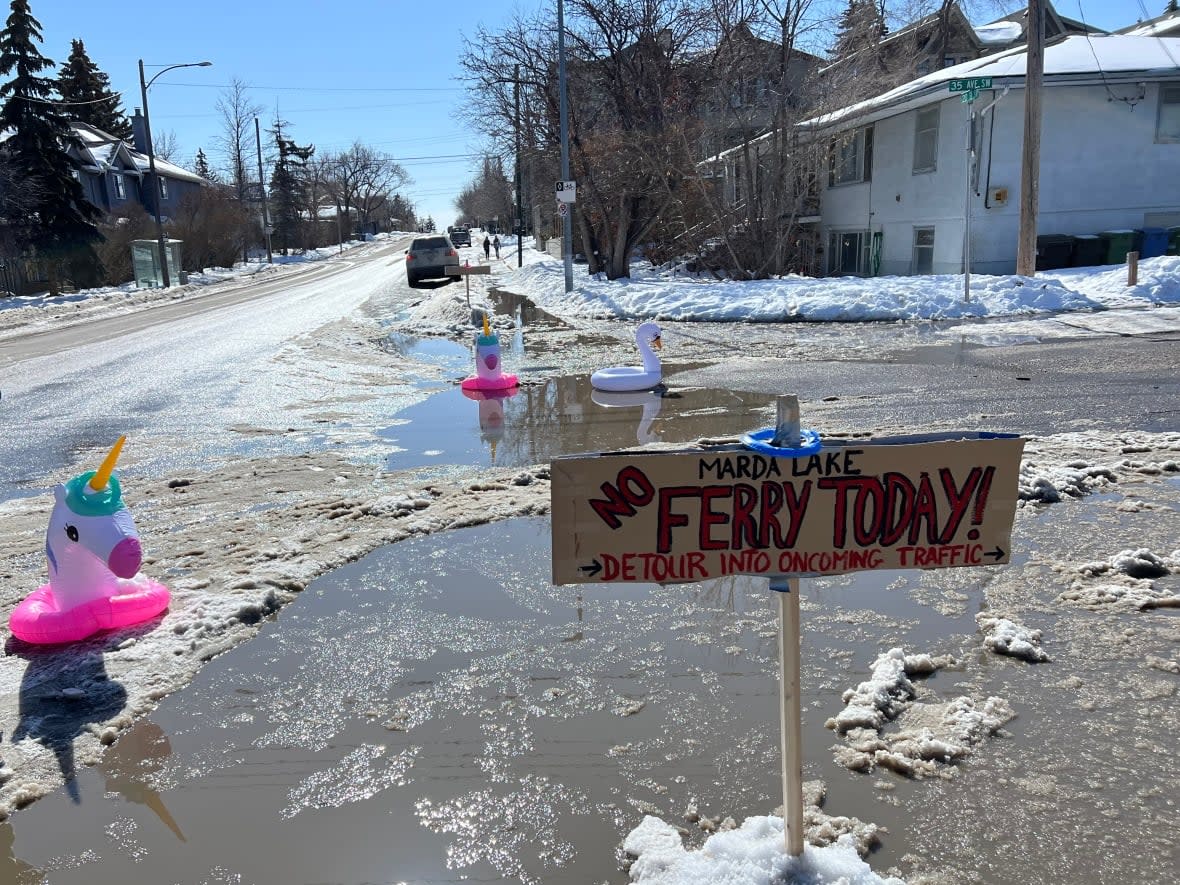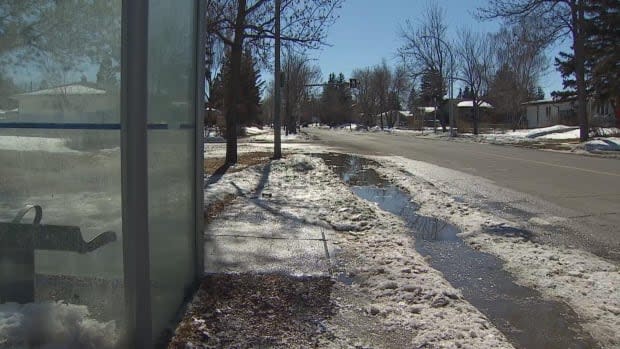City tackles more than 1,000 service requests as water pools near storm drains

Jamie Ruff says he received an upsetting call from his wife last week.
In a bid to avoid a large pool of water covering a sidewalk in Marda Loop, near 35th Avenue and 20th Street S.W., she'd climbed into a snowbank and mistakenly fallen in, drenching her clothes in the process.
Ruff immediately called the city. The buildup was coming from a blocked storm drain, and as temperatures warm and the snow blanketing the city continues to melt, the run-off had nowhere to go.
After a few days of inaction, Ruff said he decided to take matters into his own hands.
"It took me an hour and a half to get some signs prepared, and I had to go to get some floaties, like blow up some unicorns," he said. "[It] took me three hours to get mobilized to send a message to the city that, you know, I wanted them down there."
His signs dubbed the area "Marda Lake." The water went roughly halfway up his shins, Ruff said, and as he set up the display, several pedestrians applauded his efforts.
"It wouldn't have been so aggravating, but it's every year on that intersection and it's bad."

The city did clear up the storm drain on Saturday afternoon, Ruff said.
But Corey Colbran, manager of wastewater and stormwater collection for the city, said it's just one of more than 1,000 calls the city is dealing with as the warming temperatures continue to melt large piles of snow — then freeze it again overnight.
"We did have a much higher snowfall this year than last and so consequently the number of 311 service requests has certainly gone up," he said in an interview with the Calgary Eyeopener.
"Our crews are working hard to get to those and we've cleared probably 300 off the list, but certainly we continue to try and get through those."
Most of the calls have come within the last week.

Colbran said the issues range from water getting caught in ice or snow on its way to a storm drain, or the drain itself being completely frozen over.
"Those are ones that we want to hear about and know about so that we can send our specialized boiler equipment there to steam them and get them thawed and running again."
As they work through the calls, Colbran said the more urgent requests are being prioritized. That includes pooling that could pose a public safety concern, that's on a major roadway or if there's potential for damage to property.
Typically, the city responds to all requests within about five days, or within hours if the call is urgent, Colbran said.
But due to the high volume of calls right now, they're telling residents a response may take up to 30 days.
"That's just in terms of just trying to set a realistic timeline. But honestly we want to make sure that we're trying to get to those in much less than that as well," he said.
LISTEN | Corey Colbran explains where the storm drain water ends up:
Colbran said he understands residents poking a bit of fun as they deal with challenging situations, but he encourages people to be careful in areas where water has pooled.
Ruff said he felt he had to take action.
"They need to get down there when it's happening because people are trying to move around and we pay for that."
What you can do
If water is pooling on your street, Colbran said the first thing to do is send in a request to 311. Those can be submitted through the website or through the mobile app.
Adding a picture also helps them to prioritize requests.
The city doesn't want residents putting themselves into dangerous situations, he said, like if the problem is on a busy street or if the basin is frozen over.

But if the water simply isn't making it to the drain, that's when a little intervention could help.
"If there's an opportunity, just to try and create a small channel, it's amazing how quickly that water can sort of get through the ice and create a bigger channel to get to the catch basin," he said.
And as the melt continues, it may also be a good time to do a quick scan of the exterior of your home.
Cody Lacey, service manager with Doug Lacey's Basement Systems, says they get a lot of calls during the spring melt as water seeps into homes. They also see blockages in eavestroughs and sump pump discharge lines as water freezes overnight.
"Definitely big things are like ensuring that the snow is not building up against your homes, making sure that you're shoveling that away, as well as ensuring that your eavestrough downspouts are down and not blocked basically," he said.
"Keeping the snow away from those exit points so that the water can freely drain away from the foundation."

The City of Calgary has also listed a number of tips on its website, including checking furnace and exhaust vents.
It also asks residents to give water on streets some time to drain, as catch basins have devices installed that allow the water to pass through slowly, ensuring the stormwater system is not overloaded.
Colbran says he's optimistic the city will get through the majority of calls for frozen drains over the next week.


